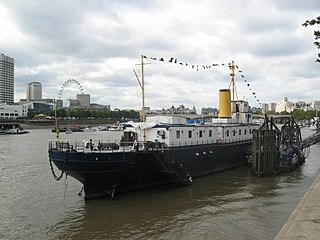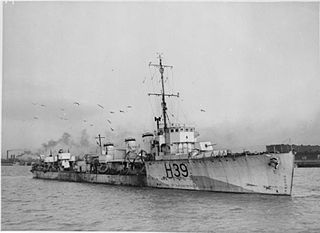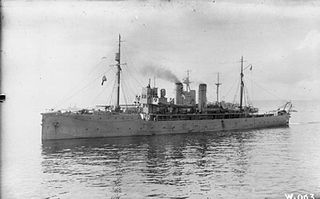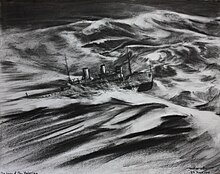
HMAS Geranium was an Arabis-class sloop built in Scotland and launched in 1915. The ship was operated by the Royal Navy as a minesweeper from 1915 until 1919, when she was transferred to the Royal Australian Navy (RAN) for use as a survey ship between 1919 and 1927. The ship was decommissioned in 1927 and scrapped during 1932, with the remains scuttled in 1935.
HMS Mallow was an Acacia-class sloop built for the Royal Navy, and later operated by the Royal Australian Navy (RAN) as HMAS Mallow.

The C class was a group of twenty-eight light cruisers of the Royal Navy, and were built in a sequence of seven groups known as the Caroline class, the Calliope class, the Cambrian class, the Centaur class, the Caledon class, the Ceres class and the Carlisle class. They were built for the rough conditions of the North Sea, and proved to be rugged and capable vessels, despite being somewhat small and cramped.

The V and W class was an amalgam of six similar classes of destroyer built for the Royal Navy under the 9th, 10th, 13th and 14th of fourteen War Emergency Programmes during the First World War and generally treated as one class. For their time they were among the most powerful and advanced ships of their type in the world, and set the trend for future British designs.
Six ships of the Royal Navy have been called HMS Imogen or HMS Imogene. A seventh was planned but never built:

The twenty-eight Anchusa-class sloops were built under the Emergency War Programme for the Royal Navy in World War I as the final part of the larger "Flower class", which were also referred to as the "Cabbage class", or "Herbaceous Borders".

The C class as designated in 1913 was a heterogeneous group of torpedo boat destroyers (TBDs) built for the Royal Navy in the late-1890s. They were constructed to the individual designs of their builders to meet Admiralty specifications. The uniting feature of the class was a top speed of 30 knots, a "turtleback" forecastle and that they all had three funnels. The funnels were spaced equidistantly and were of equal height, but the central one was thicker.

The Insect-class gunboats were a class of small, but well-armed Royal Navy ships designed for use in shallow rivers or inshore. They were intended for use on the Danube against Austria-Hungary. The first four ships—Gnat, Mantis, Moth and Tarantula—were first employed during the Mesopotamian Campaign of the First World War on the Euphrates and Tigris rivers.

The first R class were a class of 62 destroyers built between 1916 and 1917 for the Royal Navy. They were an improvement, specifically in the area of fuel economy, of the earlier Admiralty M-class destroyers. The most important difference was that the Admiralty R class had two shafts and geared turbines, compared with the three shafts and direct turbines of the Admiralty M class, but in appearance the R class could be distinguished from its predecessors by having the after 4-inch gun mounted in a bandstand. The Admiralty ordered the first two of this class of ships in May 1915. Another seventeen were ordered in July 1915, a further eight in December 1915, and a final twenty-three in March 1916.

The Flower class comprised five sub-classes of sloops built under the Emergency War Programme for the Royal Navy during World War I, all of which were named after various flowers. They were popularly known as the "herbaceous borders", in humorous reference to a well-known adage about the Royal Navy, as well as to a type of garden border popular in the United Kingdom.

The Aubrietia-class sloops were a class of twelve sloops built under the Emergency War Programme for the Royal Navy in World War I as part of the larger Flower class. They were also referred to as the "cabbage class", or "herbaceous borders". The Flowers were the first ships designed as minesweepers.

The Acacia class was a class of twenty-four sloops that were ordered in January 1915 under the Emergency War Programme for the Royal Navy in World War I as part of the larger Flower class which were also referred to as the "Cabbage class", or "Herbaceous Borders". They were ordered in two batches, twelve ships on 1 January and another twelve on 12 January, and all were launched within about four or five months, and delivered between May and September 1915. They were used almost entirely for minesweeping until 1917, when they were transferred to escort duty.
Several ships of the British Royal Navy have been named HMS Partridge, after the bird.

The 24 class was a class of minesweeping sloops. They were derived from the preceding Flower-class sloop, but designed to appear double-ended. Twenty-four ships to this design were ordered between December 1916 and April 1917 under the Emergency War Programme for the Royal Navy in World War I, although two of them were cancelled before launch. All were named after famous racehorses, but they were not named Racehorse class as the Admiralty realised that this could easily be confused in communications with the Racecourse class of paddle minesweepers, and they officially became the 24 class.
HMS Arabis was an Arabis-class sloop of the Royal Navy. She had a brief career, serving during the First World War.

HMS Foxglove was an Acacia-class minesweeping sloop of the Royal Navy. She saw service in World War I and World War II.
SS Ardena was a minesweeper and escort vessel built as an Azalea-class sloop minesweeper for the British Royal Navy with the name HMS Peony in 1915.
Two ships of the Royal Navy have borne the name HMS Buttercup, named for the buttercup flower:
Two vessels of the Royal Navy have been named HMS Primula:
HMS Cornflower was an Arabis-class sloop of the Royal Navy and from 1933 the Hong Kong Naval Volunteer Force (HKNVR).













